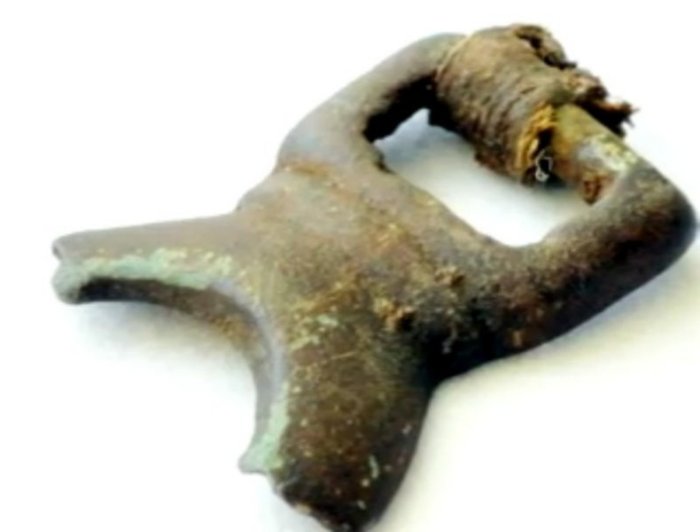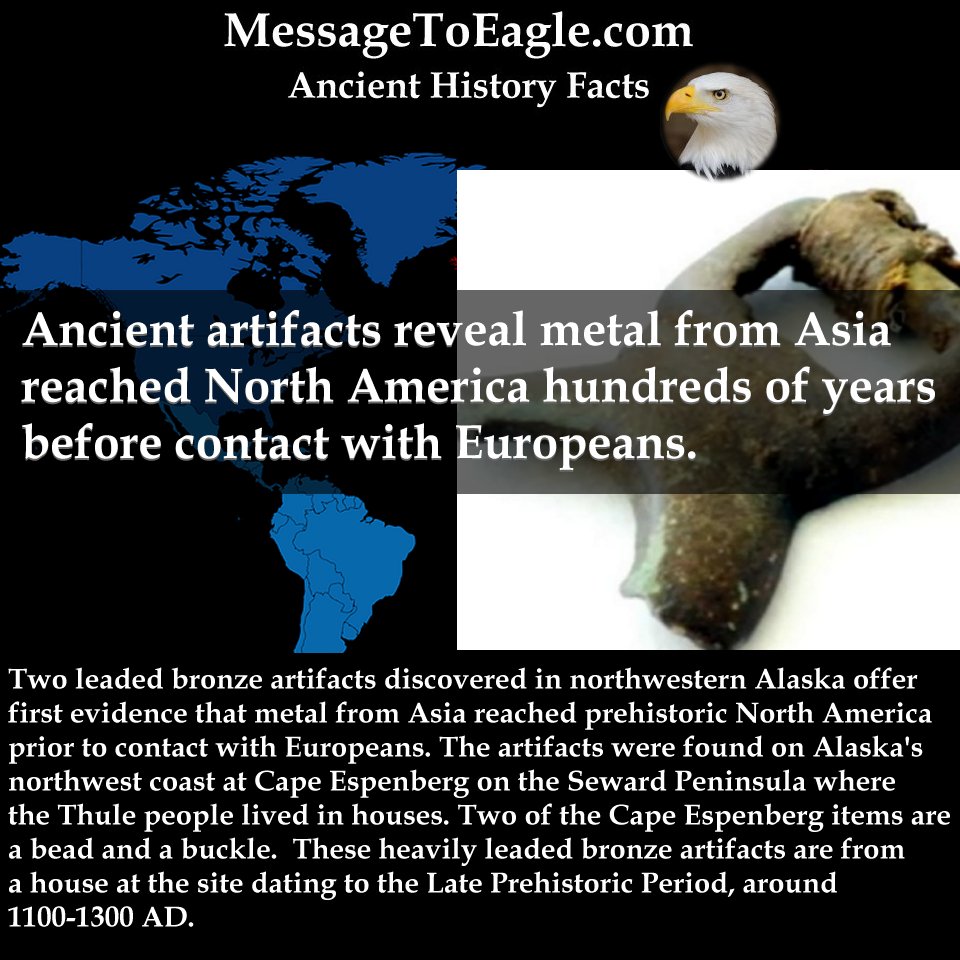Ancient Artifacts Reveal Metal From Asia Reached North America Hundreds Of Years Before Contact With Europeans
MessageToEagle.com – Two leaded bronze artifacts discovered in northwestern Alaska offer first evidence that metal from Asia reached prehistoric North America prior to contact with Europeans.
The artifacts were found on Alaska’s northwest coast at Cape Espenberg on the Seward Peninsula where the Thule people lived in houses.
Two of the Cape Espenberg items are a bead and a buckle. These heavily leaded bronze artifacts are from a house at the site dating to the Late Prehistoric Period, around 1100-1300 AD, which is before sustained European contact in the late 18th century.
Metal artifacts are rarely found because they were usually used until they were worn down and, therefore, not well preserved at field sites.
“These items are remarkable due to curation and preservation issues,” said H. Kory Cooper, an associate professor of anthropology, who led the artifacts’ metallurgical analysis.

“This is not a surprise based on oral history and other archaeological finds, and it was just a matter of time before we had a good example of Eurasian metal that had been traded.
See also:
Mysterious Sacred ‘Sign Posts’ Of The Inuit People
Evidence Of Early Metalworking In Arctic Canada – European Technologies Involved
We believe these smelted alloys were made somewhere in Eurasia and traded to Siberia and then traded across the Bering Strait to ancestral Inuits people, also known as Thule culture, in Alaska. Locally available metal in parts of the Arctic, such as native metal, copper and meteoritic and telluric iron were used by ancient Inuit people for tools and to sometimes indicate status,” Professor Cooper explained.
The cylindrical bead and a fragment of a small buckle strap-guide are composed of leaded bronze, which is an alloy of copper, tin and lead. The fragmented leather strap on the buckle provided radiocarbon dating, and the item was dated to 500-800 years old, although the metal could be older.
“The belt buckle also is considered an industrial product and is an unprecedented find for this time,” Cooper said.
“It resembles a buckle used as part of a horse harness that would have been used in north-central China during the first six centuries before the Common Era.”

Three of the other four items from another house were determined to be copper – a piece of bone fishing tackle with a copper hook, an eyed copper needle and a small fragment of sheet copper. The final item was a bone fishing lure with iron inset eyes. All items were analyzed with X-ray fluorescence technology.
MessageToEagle.com
Related Posts
-
 Ancient Human Feeding Behavior Studied By Scientists
No Comments | Jan 20, 2022
Ancient Human Feeding Behavior Studied By Scientists
No Comments | Jan 20, 2022 -
 Twelve Human Trophy Heads, One Feline Trophy Head Found In Toro Muerto Cemetery , Arequipa, Peru
No Comments | Nov 3, 2015
Twelve Human Trophy Heads, One Feline Trophy Head Found In Toro Muerto Cemetery , Arequipa, Peru
No Comments | Nov 3, 2015 -
 Ancient Artifacts Discovered In Argentina Suggest Humans Occupied South America Earlier Than Previously Thought
No Comments | Oct 4, 2016
Ancient Artifacts Discovered In Argentina Suggest Humans Occupied South America Earlier Than Previously Thought
No Comments | Oct 4, 2016 -
 Princess Ukok Cannot Be Re-Buried – Locals Think She Is Cursed
No Comments | Feb 12, 2016
Princess Ukok Cannot Be Re-Buried – Locals Think She Is Cursed
No Comments | Feb 12, 2016 -
 Stone Age Europe Had Nine Distinct Cultures – Ancient Jewelry Reveals
No Comments | Feb 12, 2024
Stone Age Europe Had Nine Distinct Cultures – Ancient Jewelry Reveals
No Comments | Feb 12, 2024 -
 Excavation Of A Mysterious 5,000-Year-Old Tomb Linked To King Arthur Has Started
No Comments | Jul 7, 2022
Excavation Of A Mysterious 5,000-Year-Old Tomb Linked To King Arthur Has Started
No Comments | Jul 7, 2022 -
 Hair From One Of The Oldest Atacama Mummies Shows Low-Stress Life In Ancient South America
No Comments | Jul 25, 2016
Hair From One Of The Oldest Atacama Mummies Shows Low-Stress Life In Ancient South America
No Comments | Jul 25, 2016 -
 Scientists Search For North America’s ‘Atlantis’ – Submerged Landscapes In The Gulf Of Mexico Studied
No Comments | Jul 15, 2024
Scientists Search For North America’s ‘Atlantis’ – Submerged Landscapes In The Gulf Of Mexico Studied
No Comments | Jul 15, 2024 -
 Tombs With Sarcophagi Of High Priests Including One Dedicated To Sky God Horus Unearthed In Egypt
No Comments | Jan 31, 2020
Tombs With Sarcophagi Of High Priests Including One Dedicated To Sky God Horus Unearthed In Egypt
No Comments | Jan 31, 2020 -
 Mystery Of The Demon Wall In Sauherad Church Finally Solved
No Comments | Dec 16, 2021
Mystery Of The Demon Wall In Sauherad Church Finally Solved
No Comments | Dec 16, 2021

